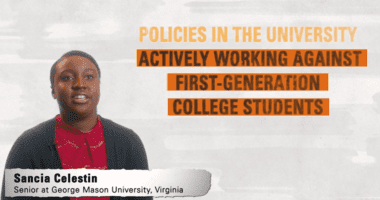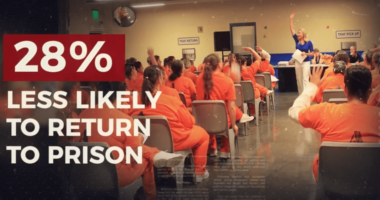Holding Up Data as a Mirror
This op-ed first appeared at Inside Higher Ed.
Around this time every year, as colleges and universities begin to spring back to life, I am reminded of my years working within central administration and the excitement in watching the sea of people full of promise come spilling back onto the campus. I remember the familiar faces of returning students, beaming with the fresh potential of a new year, who dropped by just to declare themselves back again or share goals for the year hatched over the summer.
But I also remember just as clearly the faces of the students who didn’t return. Those we lost somewhere along the way to graduation.
Many of those students still haunt me today. I remember one freshman I met when I was working as vice chancellor and chief of staff at UNC Greensboro. She came into my office at the end of the spring semester in tears. A straight-A student through high school, she arrived on our campus full of confidence. But that confidence was shattered when her professors told her that she was a terrible writer. She struggled through the year in silence, determined to improve. But she never got the help she needed. The tears rolled down that young woman’s face as she learned that she’d been placed on academic probation and would lose her scholarship. It was too late. We were too late.
There are thousands more stories like this young woman’s — of students from low-income families who could have made it farther than their parents did but whom we somehow failed along the way.
We used to blame our students: their poverty, their underpreparation, the extra burdens they carry. It turns out, though, that it’s a lot about us. Yes, poverty and preparation matter. But the choices we make matter, too. Some institutions are simply doing a much better job of graduating their students than other institutions serving exactly the same kinds of students.
As we begin a new academic year, this can be a moment for improvement-minded institutional leaders to engage campus communities in honest, data-driven conversations about what we might do better. How can we more fully understand the journeys our students take on the way to the degree, noting where those journeys are speeded and guided, and where they derail? How can we renew our collective commitment to expand what’s working and to confront — and address — what’s not?
To assist institutional leaders in their reflection and planning, Ed Trust has sought to identify and broadly share the high-impact practices of institutional leaders who have driven impressive improvement in completion rates, particularly for students who have gone historically underrepresented — and underserved — on our campuses: low-income and first-generation students and students of color. Most recently we’ve examined practices at Florida State University, San Diego State University, the University of Wisconsin Eau Claire and Georgia State University.
While each of these institutions is distinct in their mission, and each set of leaders distinct in their style, at the core of their improvement efforts are common practices and qualities — many of them steeped in honest analysis of data. Those practices and qualities are:
Courage. When then San Diego State President Stephen Weber addressed his Faculty Senate, applauding the many ways in which the faculty had worked toward — and attained — excellence over the years, he went on to issue a challenge that would spark a decade-long improvement effort: “But a great university doesn’t lose almost two-thirds of its Latino freshmen along the road toward graduation.” Like Weber, all of the leaders at the campuses we’ve been learning from are clear-eyed, intentional and dogged in their approaches to institutional improvement. They roll up their sleeves alongside staff and faculty and ask hard questions of the data on student matriculation and success. They zero in on areas of strength and weakness to draw out promising practices and needed interventions.
Shared commitment. These leaders are keenly aware that, while they have a strong role to play in leading change, staff and faculty members operating closest to their students are the ones who enact that change. Using data, leaders at University of Wisconsin Eau Claire engaged departments as partners and problem solvers. Said one senior leader on campus, “We give them the data … we’re not telling them where the problem is; they identify the problem and we encourage them to solve the problem.”
In examining their data, they found that, while their six-year graduation rate was relatively high, the four-year graduation rate was extremely low at just 18 percent. To address that pattern, faculty and staff members identified course bottlenecks and acted to remove them.
At each of the institutions we’ve studied, leaders draw together partners at every level — senior administrators, department heads, faculty members, student-affairs professionals — to engage in data analysis and problem solving. And they arrive not with answers, but with questions, trusting that those assembled in the room have much to contribute to improvement efforts.
Timely data for targeted interventions. These leaders understand that their students struggle in real time — and that those working closest to them need information to intervene in real time. Further, they know from disaggregating data that all students don’t struggle at the same time with the same obstacles or need the same supports. They take time to parse data to understand the needs of all their students — first generation, transfer, black, Latino, immigrant and many others. They identify benchmarks and warning indicators to ensure that no student is left to languish and disappear at any point in their educational journey without real supports to turn the situation around.
For example, practitioners at Georgia State University noted, “Four or five years ago, we had nothing consistent in our system that would help us track students.” Today, an impressive online data repository gives faculty and staff members immediate access to 130 screens of the most requested data on student progression and success. Through their Graduation and Progression Success advising system, which tracks more than 700 markers of student success, nightly feeds generate lists of which students have missed which markers. That information enables advisers to reach out immediately with targeted support for students who stumble.
Continuing evaluation of the data. Leaders at these institutions always come back to the data. A longtime campus leader at Florida State University described the cultural change ushered in by former provost Lawrence G. Abele: “When he came in, there was a huge shift in culture. It was no longer OK to just do things you thought were right; you needed data to support new ideas and also to assess, evaluate and improve current programs.”
For instance, when campus leaders analyzed their dropout patterns, they found that while white students were most at risk of dropping out in their first year, black male students were more likely to leave after the second, third or even fifth year. They realized that their retention efforts needed to stretch beyond freshman year to guide students through the entire undergraduate trajectory. Like Abele, leaders at these fast-improving institutions convene their teams regularly to monitor and review the data and to make mid-course corrections to ensure that their efforts, energies and resources are directed where they are most needed.
The lessons these leaders offer provide real insight from within successful college and university change efforts. They remind all of us in higher education that “success for some” is no great institution’s epitaph — that institutional success will be measured not by how well some students are served but by how well all groups of students are served. If institutional leaders and those of us working alongside them don’t have the courage to confront the reality of what’s happening on our campuses in the narratives of all students, whether on commencement lists or dropout rolls, we are merely comforting ourselves with a half-true story that plays on repeat each year.











